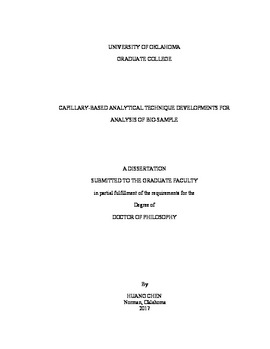| dc.description.abstract | Analytical chemistry plays a significant role in bioscience research. Bio-samples, such as DNA and proteins, are often used for identification purpose or disease related research. Analyzing a biological sample typically includes sample preparation, separation, analyte detection and identification. Of these procedures, separation is the most essential procedure because bio-samples are usually very complicated. Unseparated sample makes it impossible to detect the molecule of interest. A successful separation should isolate the analytes from matrix, which may interfere with the accuracy, precision and sensitivity of the analytical method. The establishment of a separation technique should be specific to the features of analytes, including size, pKa, molecular weight, polarity, functional group, solubility, etc. This dissertation focuses on the development of various capillary-based separation techniques towards bio-samples.
We have developed an innovative and simple approach for on-line intercalation of YOYO-1 with DNA. A capillary PCR with BaNC-HDC and this on-line intercalation approach were integrated onto a microfluidic platform. The feasibility of using this platform for multiplexed PCR, on-line intercalation of the amplified products, BaNC-HDC separation, and LIF detection was demonstared. The microfluidic platform, combining with the PCR microfluidic chips and a miniaturized LIF, holds great promises for point-of-care applications.
We have developed a simple electrokinetic means to fractionate protein samples according to their pI values and demonstrated the feasibility of using this approach for fractionating real-world samples. The method does not require sophisticated equipment, and its consumable costs are low. More importantly, the fractionated samples are MS-friendly because we eliminate the use of ampholytes that interfere with MS analysis. The method will be an excellent way to purify a specific protein (e.g., an antibody) for analytical and micropreparative purposes.
We have coupled IEX (the first-D) chromatography with multiple-column RP (the second-D) chromatography for comprehensive and 2D separation of intact proteins. With n columns incorporated in the second-D, we can theoretically reduce the speed requirement of the second-D by a factor of n. This system has been tested for separating both protein standards and E. Coli lysates; baseline resolutions were obtained for separating 11 standard proteins while more than 500 protein peaks were detected for the E. Coli lysate sample.
We have developed a fast and exceptionally high efficient single pore capillary LC to resolve amino acids and peptides; in only ten minutes separation efficiencies of more than ten millions plates per meter are already obtained. We are going to combine this separation technique with MS to make an outstanding alternative technique to conventional LC-MS. | en_US |
